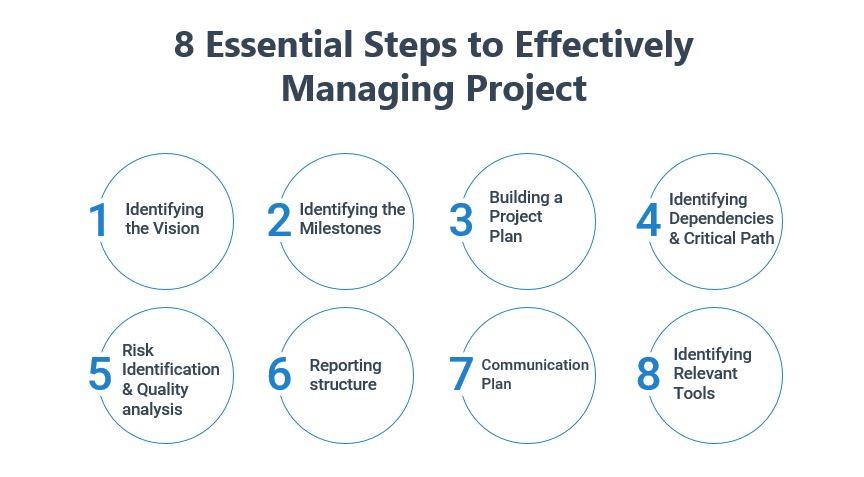8 Essential Steps to Effectively Manage Projects
Projects can be expensive and often cross the demarcated boundaries of time and budget. Take these 8 essential steps to effectively manage projects.
Join the DZone community and get the full member experience.
Join For Free
We are investing our experience in project management to provide 8 essential steps that can generate the maximum chance of project success. We will not be discussing any specific project management framework but will discuss the critical structure that will help you lead your project from day 1.

Step 1: Identifying the Vision
A project is said to be successful when it meets the needs of a stakeholder. A stakeholder can be anyone who is affected directly or indirectly by the project outcome. A few examples (not an extensive list) of stakeholders are:
- Project sponsor
- Customer receiving the deliverables
- User of the project outcome
- Project managers and Project team
It is essential to get the project team along with the stakeholders, in line with the goals of a project. Start with the most basic questions like:
- Why are you doing this project?
- What do you want to achieve by the project?
Discuss the outcomes of the project with the stakeholders. The objective of this step is to identify the main aim of doing the project, and the deliverable for this step should be a statement describing the vision and the critical outputs of the projects.
Step 2: Identify the Milestones
By the end of Step 1, you will be able to identify the direction of the project. This is the time when you breakdown the primary outcomes to smaller milestones that can be tracked. Identifying the milestones will help you in building a structure, which will, in turn, help in making a project plan.
The process of identifying the milestones can start by marking the most significant and apparent milestones initially. It is good to include the project team in the process. Start with the basic questions like “When does the project start”, “When does the project finish?”, “What do we need to create, and by when?”
Try to identify milestones that are crucial to keeping the project on track. Milestones are necessary, and you should make sure that the team understands these milestones and identifies the consequences of not meeting the milestones.
Once you have identified the milestones, it is crucial to identify the risks associate with the milestones and find solutions to these risks.
Also, make sure you put a time stamp on each of the milestones. Time is always a crucial element in the success of a project, and putting a timestamp on the milestone will help you identify if you are on schedule during the execution.
Step 3: Building a Project Plan
In this step, you add details to the milestone. You will have to identify the activities associated with each milestone. The nature of the activities depends on factors like the size of the project and the project management framework. If you are following the waterfall model, the activities will mostly be sequential. However, if you are using agile, you will have to designate a timeline for various stages.
The Work Breakdown Structure is going to be the base outcome of this step. This is also the time to determine the cost baseline, delegate tasks, and assign resources. Now that you have a clearer picture of the activities, tasks, and work packages, it will be easier for you to allocate resources. It is also essential to mark resource constraints and make it known to the project team.
Activities like stakeholder approvals, marketing endeavors, and 3rd party action items need to be identified in this step. Remember that you need just enough information to devise a plan and need not worry about adding every activity in this stage. The plan that you have created now will evolve over the time where you might have to add tasks or address new risks.
Step 4: Identifying the Dependencies and Critical Path
Step 4 is very closely related to step 3. This is where you will take a closer look at the activities and try to determine the dependencies. Dependencies are the relation of the preceding task to the succeeding task. Again, you should not aim at identifying all the dependencies. It is good to start with the significant dependencies and planning for them.
Once you have identified the critical dependencies, you should look at removing dependencies or at minimizing them. You might have to add more activities to mitigate the dependency. This is more of an optimization process, and you might have to rethink the order of work.
Step 5: Risk Identification and Quality Analysis
Risk is an event that may or may not happen but can have a significant effect on the outcome. Risk identification is not just a one-time activity but an approach that needs to be integrated into all your endeavors. Not only should you include the project health check action at the start of the project, but in all the planning meetings.
Brainstorming is the first step where you ask the project team, ”What could go wrong?” Risk management is not limited to identifying the risk. It includes developing a plan if the risk occurs. Pay attention to the probability and impact of the identified risks to identify the high risks that need critical attention. A risk management plan should include plans to understand and communicate how teams should respond to high-risk events.
Creating a quality plan involves setting the standards, acceptance criteria, and metrics that will be used throughout the project. The plan, then, becomes the foundation for all the quality reviews and inspections performed during the project and is used throughout project execution.
Step 6: Reporting Structure
This might not strike as a bare necessity; however, the availability of relevant data can turn out to be a prime tool during project management. It is always important to ask “Why” for each report. While the availability of information is good, too much reporting can slow the team down and prevent them from working on high project value actions. So how do you identify the essential reporting?
- The first step to ask the project team and stakeholders what information they would need.
- Identify information, without which, clients can't do their jobs.
- Identify templates for reports if necessary, along with designating the responsibility of sending the reports. Also, decide on the frequency of the report.
Step 7: Communication Plan
The communication plan is a bit broader than the reporting plan and includes critical decisions like:
- How issues will be escalated and when?
- Where will the project information be stored and who can access them?
The formal communication matrix helps document the project team's agreed-on method for communicating various aspects of the project, such as routine status, problem resolution, decisions, etc.
Once the project plan is complete, it is essential not just to communicate the importance of the project plan to the sponsor, but also to communicate its contents once it's created.
Step 8: Identifying Relevant Tools
Project management tools can significantly boost the productivity of the team. Very often, the selection of tools is not given priority, and organizations have various project management tools in place, and one is expected to use them. However, it is prudent to compare the plan you have created with the tools at your disposal. Pay attention to factors like reporting risk management, communication, emails, file storage, etc.
Discuss with the team the tools they need and identify the critical tools: tools that are necessary for the project. Consider tools that have not been identified as critical. Check if these tools can be removed entirely, or will they have utility through the project execution? Also, identify tools that have been mandated by company policies and share the information with the team.
So this was the 8 Essential steps to effectively managing your project. Managing projects can be tedious, and it is easy to fall in the trap of controlling everything, rather utilize the project team. The competency of managing projects effectively can be acquired. If you feel you need more elaborate help and learning in the project management spectrum, you can take up specialized training in the domain. There are several project management certifications like PMP , CAPM , PMI-ACP , CSM, etc. that provide an excellent learning opportunity in the field.
Happy Learning!
Opinions expressed by DZone contributors are their own.

Comments